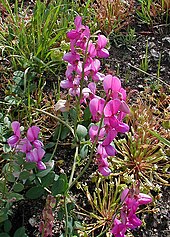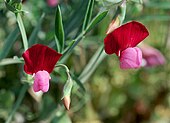Flat peas
| Flat peas | ||||||||||||
|---|---|---|---|---|---|---|---|---|---|---|---|---|

Left: grass pea ( Lathyrus nissolia ) and right: vine pea ( Lathyrus aphaca ) |
||||||||||||
| Systematics | ||||||||||||
|
||||||||||||
| Scientific name | ||||||||||||
| Lathyrus | ||||||||||||
| L. |
The grass pea ( Lathyrus ) are a genus in the subfamily Pea (Faboideae) within the family of legumes (Fabaceae). The approximately 160 species occur mainly in the temperate areas of the northern hemisphere .
Description and ingredients
Vegetative characteristics
The flat peas are annual or perennial herbaceous plants , runners can occur. In some species the stems are winged. Depending on the species, the alternate or opposing leaves are usually pinnate in pairs and end in a tendril . More rarely, the leaves are reduced to a tendril or a grass-like phyllodium . The leaflets are mostly parallel-veined. The stipules are mostly herbaceous.

Generative characteristics
The lateral, more or less long-stalked, racemose inflorescences contain one to 30 flowers . The cover sheets are mostly obsolete and front sheets are missing. The hermaphrodite flowers are zygomorphic and five-fold with a double flower envelope . The calyx is radial symmetry to two-lipped and mostly quite short. The shuttle is usually curved and rather blunt. The top of the ten stamens is free, the stamen tube is cut off at right angles. The ovary is stalked to almost sessile. The stylus, which is often flattened on the upper side, is curved to twisted, is hairy on the upper side and on the edges, rarely bald. In some species the flower is asymmetrical due to a rotation of the genital column and the shuttle.
The legumes, which are mostly elongated and flattened, jump up into two lobes and contain two or more seeds . The seeds in particular contain lathyrogenic amino acids in several species, L- oxalyldiaminopropionic acid and butyric acid . This makes them poisonous and causes what is known as lathyrism . The propionic acid derivatives are probably responsible for this .










Flower biology
From an ecological point of view, it is nectar-bearing butterfly flowers with a brush mechanism. The pollination occurs mainly by hymenoptera (Hymenoptera). Some species are also autogamous , and cleistogamous flowers close to the ground are rare .
Occurrence
The flat pea species are native to the temperate areas of the northern hemisphere, some species extend as far as tropical East Africa and temperate South America. They are absent in the tropics. The center of diversity is in the eastern parts of the Mediterranean, with smaller centers in North and South America.
The flat pea species grow in diverse locations such as open forests, forest edges, meadows, pastures, fields, mountain slopes, marshes, coasts, sand dunes and roadsides.
Systematics
Synonyms for Lathyrus L. are: Aphaca Mill. , Konxikas Raf. , Orobus L.
The genus flat peas ( Lathyrus ) belongs to the tribe Fabeae ( Syn .: Vicieae) in the subfamily of the Faboideae . With around 160 species, it is the most species-rich genus. It is divided into several sections , which is largely supported by molecular genetic analyzes. Here is a list of selected species:
- Lathyrus Section : It contains about 34 species, including:
- Annual flat pea ( Lathyrus annuus L. ); Home: Europe, North Africa, Middle East to Central Asia
- Red pea ( Lathyrus cicera L. ); Home: Europe, North Africa, Middle East to Central Asia
- Fragrant flat pea , commonly known as sweet pea or garden pea ( Lathyrus odoratus L. ); Homeland: Southern Italy, Sicily, Aegean Sea, otherwise partially naturalized
- Lathyrus rotundifolius Willd. ; Home: Eastern Europe and the Middle East
- Common pea ( Lathyrus sativus L. ); Homeland: West Asia?, Naturalized in North Africa, Europe and the Middle East
- Lathyrus setifolius L .; occurs in the Mediterranean area
- Wood pea ( Lathyrus sylvestris L. )
- Tangier pea ( Lathyrus tingitanus L. )
- Tuberous pea ( Lathyrus tuberosus L. )
- Section Lathyrostylis (Griseb.) Bässler : It contains about 20 perennial, upright species, including:
- Lathyrus digitatus (M.Bieb.) Fiori ; Home: Eastern Mediterranean, Southeast Europe, Asia Minor, Italy, Libya
- Lathyrus filiformis (Lam.) Gay ; Home: Spain, France, Italy, Algeria, Morocco
- Lathyrus pallescens (M.Bieb.) K.Koch ; occurs in Southeast Europe and Asia Minor
- Lathyrus spathulatus Čelak. ; Home: Middle East
- Section Linearicarpus Kupicha : It contains about seven species, including:
- Lathyrus angulatus L .; occurs in southern Europe and north Africa
- Globular pea ( Lathyrus sphaericus Retz. ); Home: Europe, North Africa, Asia
- Section Notholathyrus Kupicha : It contains about 23 species, including:
- Lathyrus hookeri G.Don , occurs in Chile
- Lathyrus magellanicus Lam. , occurs in South America
- Lathyrus multiceps Clos , occurs in Chile
- Lathyrus nervosus Lam. , occurs in South America
- Lathyrus pubescens Hook. & Arn. , occurs in Chile
- Lathyrus subandinus Phil. , Occurs in Chile
- Section Orobus (L.) Gren. & Godr. : Is listed by some authors as a separate genus, which is not supported by molecular genetic studies. It contains about 50 species, including:
- Lathyrus alpestris (Waldst. & Kit.) Čelak. ; Home: Balkan Peninsula
- Lathyrus aureus (Steven) D.Brândza ; occurs on the Balkan Peninsula and in Asia Minor
- Lathyrus davidii Hance ; Home: Northern China, Amur region, Japan, Korea, Russia
- Lathyrus delnorticus C.L. Hitchc. , occurs in the United States
- Lathyrus glandulosus Broich , occurs in California
- Lathyrus gmelinii Fritsch ; Home: Urals, Central Asia, China (Xinjiang)
- Lathyrus holochlorus (Piper) CLHitchc. : Homeland: Oregon
- Lathyrus humilis (Ser.) Spreng. ; Home: Urals and Asia
- Beach pea ( Lathyrus japonicus Willd .; Incl.Lathyrus maritimus Bigelow )
- Lathyrus jepsonii Greene , occurs in California
- Lathyrus komarovii Ohwi ; occurs in China, Korea and Russia
- Yellow flat pea ( Lathyrus laevigatus (Waldst. & Kit.) Gren. ); Home: Europe
- Lathyrus lanszwertii Kellogg , occurs in North America
- Mountain flat pea ( Lathyrus linifolius (Reichard) Bässler , Syn .: Lathyrus montanus Bernh. )
- Lathyrus littoralis (Torr. & A.Gray) Walp. , occurs in North America
- Lathyrus nevadensis S. Watson , occurs in California
- Black pea ( Lathyrus niger (L.) Bernh. )
- Marsh pea ( Lathyrus palustris L. )
- Pea-like flat pea ( Lathyrus pisiformis L. ); occurs in Central and Eastern Europe
- Lathyrus polyphyllus Torr. & A. Gray , occurs in North America
- Lathyrus quinquenervius (Miq.) Litv. ; occurs in Russia, China, Korea and Japan
- Lathyrus rigidus T.G. White , is found in North America
- Lathyrus splendens Kellogg , occurs in California
- Lathyrus sulphureus Brewer ex A. Gray , occurs in California
- Lathyrus transsylvanicus (Spreng.) Rchb. ; Home: Carpathian Mountains
- Lathyrus vaniotii H.Lév. , occurs in China and Korea
- Spring pea ( Lathyrus vernus (L.) Bernh. )
- Lathyrus vestitus Torr. & A.Gray , found in North America
- Section Aphaca (Adans.) Rchb. : It contains about two types, including:
- Vine pea ( Lathyrus aphaca L .; incl.Lathyrus pseudoaphaca Boiss. )
- Pratenses section : it contains about six species, including:
- Lathyrus laxiflorus (Desf.) Kuntze ; Home: Italy, Balkan Peninsula, Crimea, Western Asia
- Meadow pea ( Lathyrus pratensis L. )
- Section Clymenum (Mill.) Ser. : It contains three or four types:
- Purple pea ( Lathyrus clymenum L. ); Home: Southern Europe, Turkey, North Africa
- Lathyrus gloeospermus Warb. & Eig ; Home: Lebanon, Syria, Palestine
- Wing pea ( Lathyrus ochrus (L.) DC. ); Home: Southern Europe, North Africa, Western Asia
- Neurolobus section : It contains only one type:
- Lathyrus neurolobus Boiss. & Hero. ; Home: Crete
- Section Nissolia (Adans.) Rchb. : It contains only one type:
- Grass pea ( Lathyrus nissolia L. )
The species found in Central Europe are:
- Vine pea ( Lathyrus aphaca L. )
- Sword-leaved flat pea or sword- leaved flat pea ( Lathyrus bauhini P.A.Genty )
- Mixed-leaved pea ( Lathyrus heterophyllus L. ); Home: Central and Southern Europe, Sweden
- Hairy pea ( Lathyrus hirsutus L. )
- Yellow pea ( Lathyrus laevigatus (Waldst. & Kit.) Gren. )
- Broad-leaved pea ( Lathyrus latifolius L. )
- Mountain pea ( Lathyrus linifolius (Reichard) Bässler )
- Beach pea ( Lathyrus japonicus Willd. , Incl.Lathyrus maritimus Bigelow )
- Black pea ( Lathyrus niger (L.) Bernh. )
- Grass pea ( Lathyrus nissolia L. )
- Sweet pea ( Lathyrus odoratus L. )
- Marsh pea ( Lathyrus palustris L. )
- Pannonian flat pea ( Lathyrus pannonicus (Jacq.) Garcke )
- Pea-like flat pea ( Lathyrus pisiformis L. )
- Meadow pea ( Lathyrus pratensis L. )
- Common pea ( Lathyrus sativus L. )
- Globular pea ( Lathyrus sphaericus Retz. )
- Wood pea ( Lathyrus sylvestris L. )
- Tuberous pea ( Lathyrus tuberosus L. )
- Colorful flat pea or Venetian flat pea ( Lathyrus venetus (Mill.) Wohlf. ); Home: Central, South and Southeastern Europe, Turkey
- Spring pea ( Lathyrus vernus (L.) Bernh. )
meaning
Among the flat peas there are food and fodder plants as well as ornamental plants. Some species are used for nitrogen fertilization and as dune stabilizers, while others are major weeds.
swell
- Syed Irtifaq Ali: Lathyrus. In: Syed Irtifaq Ali (ed.) Flora of West Pakistan. Volume 100: Papilionaceae. Stewart Herbarium, Rawalpindi 1977, p. 275 (online).
- Bojian Bao, Gregory Kenicer: Lathyrus. In: Wu Zheng-yi, Peter H. Raven, Deyuan Hong (Eds.): Flora of China . Volume 10: Fabaceae . Science Press / Missouri Botanical Garden Press, Beijing / St. Louis 2010, ISBN 978-1-930723-91-7 , pp. 572 (English, online ).
- Siegmund Seybold (Ed.): Schmeil-Fitschen interactive . CD-ROM, version 1.1. Quelle & Meyer, Wiebelsheim 2002, ISBN 3-494-01327-6 .
- Ingrid Schönfelder, Peter Schönfelder : Kosmos-Atlas Mediterranean and Canary Islands flora. Over 1600 species of plants . Franckh-Kosmos, Stuttgart 1994, ISBN 3-440-06223-6 .
- Walter Erhardt , Erich Götz, Nils Bödeker, Siegmund Seybold: The great pikeperch. Encyclopedia of Plant Names. Volume 2. Types and varieties. Eugen Ulmer, Stuttgart (Hohenheim) 2008, ISBN 978-3-8001-5406-7 .
- Werner Greuter, Hervé-Maurice Burdet, Guy Long (eds.): Med-Checklist. A critical inventory of vascular plants of the circum-Mediterranean countries . Vol. 4: Dicotyledones (Lauraceae - Rhamnaceae) . Conservatoire et Jardin Botanique, Genève 1989, ISBN 2-8277-0154-5 , pp. 114-125 ( online ).
Individual evidence
- ^ A b Conny B. Asmussen, Aaron Liston: Chloroplast DNA characters, phylogeny, and classification of Lathyrus (Fabaceae). In: American Journal of Botany. Vol. 85, No. 3, 1998, pp. 387-401 (abstract) .
- ^ A b Lathyrus in the Germplasm Resources Information Network (GRIN), USDA , ARS , National Genetic Resources Program. National Germplasm Resources Laboratory, Beltsville, Maryland.
- ↑ a b Gregory J. Kenicer, Tadashi Kajita, R. Toby Pennington, Jin Murata: Systematics and biogeography of Lathyrus (Leguminosae) based on internal transcribed spacer and cpDNA sequence data. In: American Journal of Botany. Volume 92, No. 7, 2005, pp. 1199-1209, DOI: 10.3732 / ajb.92.7.1199 .
- ^ Siegmund Seybold (Ed.): Schmeil-Fitschen interactive . CD-ROM, version 1.1. Quelle & Meyer, Wiebelsheim 2002, ISBN 3-494-01327-6 .